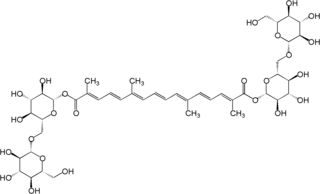Crocin
Crocina es un compuesto químico natural de carotenoides que se encuentra en la flor de especies de crocus y gardenia.[2] Es el diéster formado a partir del disacárido gentiobiosa y el ácido dicarboxílico crocetina. Tiene un color rojo intenso y forma cristales con un punto de fusión de 186 °C. Cuando se disuelve en agua, forma una solución de color naranja.
| Crocin | ||
|---|---|---|
 | ||
| Nombre IUPAC | ||
| Bis[(2S,3R,4S,5S,6R)-3,4,5-trihydroxy-6-({[(2R,3R,4S,5S,6R)-3,4,5-trihydroxy-6-(hydroxymethyl)tetrahydro-2H-pyran-2-yl]oxy}methyl)tetrahydro-2H-pyran-2-yl] (2E,4E,6E,8E,10E,12E,14E)-2,6,11,15-tetramethyl-2,4,6,8,10,12,14-hexadecaheptaenedioate | ||
| General | ||
| Fórmula estructural |
 | |
| Fórmula molecular |
C 44H 64O 24 | |
| Identificadores | ||
| Número CAS | 42553-65-1[1] | |
| ChEBI | 79068 | |
| ChEMBL | CHEMBL446785 | |
| ChemSpider | 4444645 | |
| DrugBank | DB11874 | |
| PubChem | 5281233 | |
| UNII | 877GWI46C2 | |
| KEGG | C08589 | |
|
O=C(O[C@@H]1O[C@@H]([C@@H](O)[C@H](O)[C@H]1O)CO[C@@H]2O[C@H](CO)[C@@H](O)[C@H](O)[C@H]2O)\C(=C\C=C\C(=C\C=C\C=C(\C=C\C=C(\C(=O)O[C@@H]4O[C@H](CO[C@@H]3O[C@H](CO)[C@@H](O)[C@H](O)[C@H]3O)[C@@H](O)[C@H](O)[C@H]4O)C)C)C)C
| ||
|
InChI=1S/C44H64O24/c1-19(11-7-13-21(3)39(59)67-43-37(57)33(53)29(49)25(65-43)17-61-41-35(55)31(51)27(47)23(15-45)63-41)9-5-6-10-20(2)12-8-14-22(4)40(60)68-44-38(58)34(54)30(50)26(66-44)18-62-42-36(56)32(52)28(48)24(16-46)64-42/h5-14,23-38,41-58H,15-18H2,1-4H3/b6-5+,11-7+,12-8+,19-9+,20-10+,21-13+,22-14+/t23-,24-,25-,26-,27-,28-,29-,30-,31+,32+,33+,34+,35-,36-,37-,38-,41-,42-,43+,44+/m1/s1
Key: SEBIKDIMAPSUBY-RTJKDTQDSA-N | ||
| Propiedades físicas | ||
| Masa molar | 976,96 g/mol | |
| Valores en el SI y en condiciones estándar (25 ℃ y 1 atm), salvo que se indique lo contrario. | ||
Crocina es el ingrediente químico principal responsable del color del azafrán.
Efectos fisiológicos
editarCrocina ha demostrado que es un potente antioxidante neuronal.[3][4][5] También se ha demostrado que tienen una acción antiproliferativa contra las células cancerosas in vitro.[6][7][8] La evidencia limitada sugiere unas posibles propiedades antidepresivas de la crocina en ratones[9] y los seres humanos.[10] Un estudio reporta propiedades afrodisíacas en ratas macho a dosis muy altas.[11]
Referencias
editar- ↑ Número CAS
- ↑ «Chemical Information». sun.ars-grin.gov. Archivado desde el original el 8 de noviembre de 2004. Consultado el 2 de marzo de 2008.
- ↑ Papandreou MA, Kanakis CD, Polissiou MG, Efthimiopoulos S, Cordopatis P, Margarity M, Lamari FN. (2006). «Inhibitory activity on amyloid-beta aggregation and antioxidant properties of Crocus sativus stigmas extract and its crocin constituents». J Agric Food Chem. 54 (23): 8762-8. PMID 17090119. doi:10.1021/jf061932a.
- ↑ Ochiai T et al. (2006). «Protective effects of carotenoids from saffron on neuronal injury in vitro and in vivo». Biochim Biophys Acta. 1770 (4): 578-584. PMID 17215084. doi:10.1016/j.bbagen.2006.11.012.
- ↑ Zheng YQ, Liu JX, Wang JN, Xu L. (2006). «Effects of crocin on reperfusion-induced oxidative/nitrative injury to cerebral microvessels after global cerebral ischemia». Brain Res. 1138: 86-94. PMID 17274961. doi:10.1016/j.brainres.2006.12.064.
- ↑ Escribano J, Alonso GL, Coca-Prados M, Fernandez JA. (1996). «Crocin, safranal and picrocrocin from saffron (Crocus sativus L.) inhibit the growth of human cancer cells in vitro». Cancer Letters 100 (1–2): 22-30. PMID 8620447. doi:10.1016/0304-3835(95)04067-6.
- ↑ Chryssanthi DG, Lamari FN, Iatrou G, Pylara A, Karamanos NK, Cordopatis P. (2007). «Inhibition of breast cancer cell proliferation by style constituents of different Crocus species». Anticancer Research 27 (1A): 357-62. PMID 17352254.
- ↑ Abdullaev Jafarova F, Caballero-Ortega H, Riverón-Negrete L, Pereda-Miranda R, Rivera-Luna R, Manuel Hernández J, Pérez-López I, Espinosa-Aguirre JJ. (2002). «In vitro evaluation of the chemopreventive potential of saffron». Rev. Invest. Clin. 54 (5): 430-6. PMID 12587418.
- ↑ Hosseinzadeh, H; Jahanian, Z (2010). «Effect of Crocus sativus L. (saffron) stigma and its constituents, crocin and safranal, on morphine withdrawal syndrome in mice». Phytotherapy research : PTR 24 (5): 726-30. PMID 19827024. doi:10.1002/ptr.3011.
- ↑ Akhondzadeh, S; Fallah-Pour, H; Afkham, K; Jamshidi, AH; Khalighi-Cigaroudi, F (2004). «Comparison of Crocus sativus L. And imipramine in the treatment of mild to moderate depression: A pilot double-blind randomized trial ISRCTN45683816». BMC Complementary and Alternative Medicine 4: 12. PMC 517724. PMID 15341662. doi:10.1186/1472-6882-4-12.
- ↑ Hosseinzadeh H, Ziaee T, Sadeghi A (junio de 2008). «The effect of saffron, Crocus sativus stigma, extract and its constituents, safranal and crocin on sexual behaviors in normal male rats». Phytomedicine 15 (6–7): 491-5. PMID 17962007. doi:10.1016/j.phymed.2007.09.020.
Enlaces externos
editar- Esta obra contiene una traducción derivada de «Crocin» de Wikipedia en inglés, publicada por sus editores bajo la Licencia de documentación libre de GNU y la Licencia Creative Commons Atribución-CompartirIgual 4.0 Internacional.